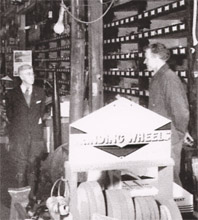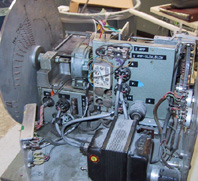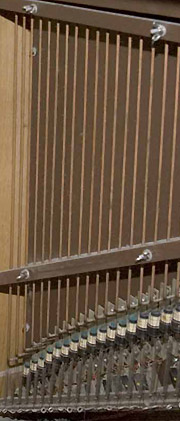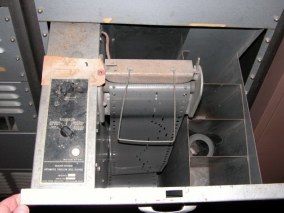Barrack Memorial Carillons (UAF)
James E. Barrack Memorial Carillons
Fairbanks Campus

Description: A symphonic carillon made by the Maas-Rowe Company in California was installed in March 1955 in the Eielson Memorial Building. Ruth Barrack of Fairbanks donated $10,000 to purchase the carillon in memory of her late husband, James. This was one of the largest donations made to the university to date in 1955.
The symphonic carillon looks like a small, plain piano, with two keyboards that have
34 keys. It is played in a similar manner to an organ. Yet, underneath the plain wood
and metal exterior lies the heart of the music and the genius of it. Here a series
of finely crafted, musically tuned rods that look like stretched-out Allen wrenches,
are struck by a hammer to make bell sounds akin to those of the Big Ben bell tower
in London.
With a symphonic carillon there is no need to house all the varying sizes of cast-iron
bells swinging from a bell tower. The tones reproduced from these struck rods are
amplified to simulate the same sound and beauty of the entire spectrum of full-size
cast-iron bells. This instrument not only rings musical numbers and chimes on the
hour and quarter hour like a clock, but also stands as a symbol of academia.

1. Keyboard Console
Live concerts could be played through the keyboard by a carilloner and broadcast through
outdoor speakers. The keyboard console contained its own set of toned rods or bells
that were up to 24 inches in length.
2. Hour Toll Clock
The old "Hour Toll Clock" used a large wheel with a series of steel spokes coming
out of it to ring the bells. The spokes were placed in strategic locations, and as
the wheel rotated, it would cause a hammer to strike a rod—a very cleverly designed
mechanism. Interestingly, the hour toll clock had its own set of toned rods contained
in a 8-inch tall, brown metal box bolted to a wall.

The new upgraded electronic Hour Toll Clock is completely programmable with a flashing
digital crystal LCD display. It looks rather odd placed in this World War II style
metal cabinet.
3. Plastic Roll Player
The old "plastic roll-player" used long sheets of plastic punched with holes on a
roll. As the plastic sheet moved through the machine, the holes allowed this series
of metal "fingers" to come in contact with a metal drum. The drum being grounded allowed
the "fingers" to close the electrical circuit and all the other related actions to
occur that sounded the bells.
The price of the plastic tape with musical compositions for the carillon punched into
it was $72 each in 1955. Six tunes could be recorded on one roll of tape. Individuals
and organizations occasionally purchased this recorded music for the university.
How it Worked
The console and toll clock each have a series of 68 rods. The plastic roll player
shares rods with the Hour Toll Clock. The rods differ in length, from small to large,
and are bent to a right angle on each end. Each rod is designed to resonate one musical
note. The rods are suspended in air by four thin threads and one end of the rod is
suspended over a magnet with a coil wrapped around it. The physical action of pressing
a key or of the rotating toll clock spoke touching metal creates an electronic impulse
that signals a small solenoid to be activated. When the identified rod is hit with
a striker, the sound is picked up and amplified and broadcast through outdoor speakers.
In 2003 the carillon unit was upgraded with a CD player. It plays pre-recorded carillon
music through the loudspeakers. Originally the only way to play music was for a person
to use the piano console or by using the plastic roll-player.
Ongoing Carillon Care and Maintenance
The carillons were first played at a concert on Easter Sunday in 1955. It was officially
dedicated at commencement that May. The eight speakers for the carillon were installed
atop the university water tower (between Eielson and Gruening buildings).

Depending on the direction of the wind bells and music could sometimes be heard across
the entire College area. The piano console, the roll player and hour toll clock were
originally housed nearby in room 218 of the Eielson building.
The carillon has been moved and renovated several times over the years. For a while
it was installed in the basement of Constitution Hall, hidden behind ventilation equipment.
Bennie Benevento and Bill Zito renovated it in the mid-1980s. The musical range was
expanded and the mechanism and keyboard were moved to the control room above the Charles
Davis Concert Hall. The speakers were relocated to the top of the Gruening Building.
In 2003 the carillon was upgraded with a CD player and a new programmable hour toll
clock and the carillon was also installed in its present location—the basement of
the Gruening Building. The piano unit was then moved to a roof top storage room in
the Music Department. UAF Music Professor David Stech played the carillon for commencement.
For a few years he would have a temporary connection wire stretched from the rooftop
storage room of the Fine Arts Complex to the main unit in the basement of the Gruening
Building. However, to hear the sound of the music, he had to open the storage room
door to the outside. He then have to adjusted his pace, as the music he was hearing
was significantly delayed as the sound travelled to the bell chime system, then amplified
through the speakers back to him. After the CD player was installed, Professor Stech
was able to prerecord the commencement music which enabled him to participate in the
commencement excercises.
Currently, the carillon is programmed to sound through the broadcast speakers on each
quarter of the hour. It chimes a longer melody at noon and 5pm. UAF's only carillon
player, David Stech notes that playing the carillon requires a unique set of skills
and style different from playing the piano. Carillon players must be cultivated and
trained on the instrument in order to be proficient players.
Today the piano unit is playable, but in storage in the Fine Arts Building. Its appearance
is pretty rough and desperately in need of being refinished. The keys and chiming
rods are in good working order, but the woodwork would benefit from refinishing. To
be usable, this piano unit needs to be moved near the main unit or permanently wired
across the main campus to be plugged into the broadcast unit. Stech suggests moving
the console unit to the basement of the Gruening Building, then plugging it in and
allowing access for it to be played. Another option would be to place the carillon
in a location where it can be seen, played and appreciated. Benevento said that this
would honor the gift made by Ruth Barrack.
In the recent past, the carillon was mainly played for the graduation ceremony and
alumni events. However, since graduation has been moved off campus, the traditional
role of the carillon has officially ended.
Presently there is a small effort lead by Benevento to make a visual display case
showing the old inner hour toll clock working, and having it softly chime at each
quarter hour, in hopes of drawing interest to the carillon. This display would also
describe and direct people to information about the carillon's history.
Notable People: James E. Barrack and Ruth Barrack
